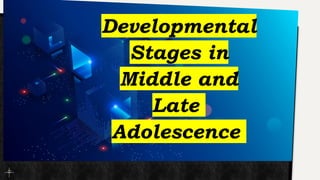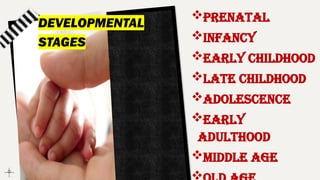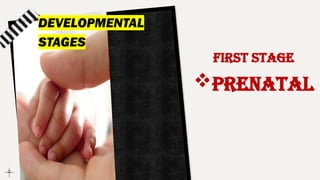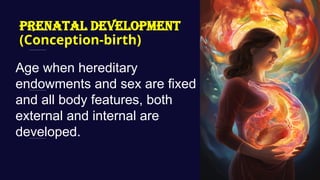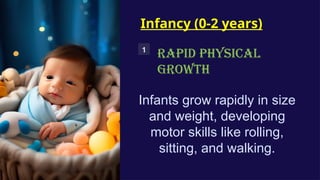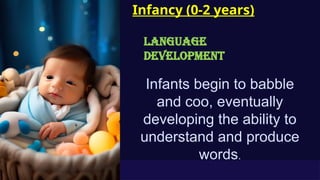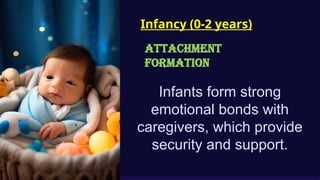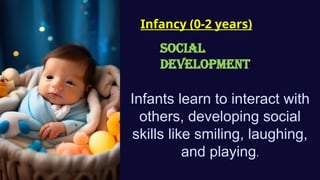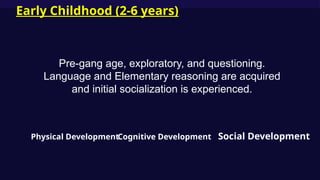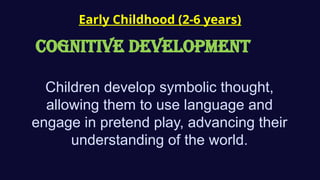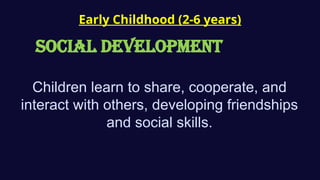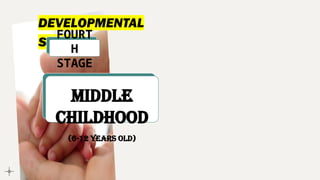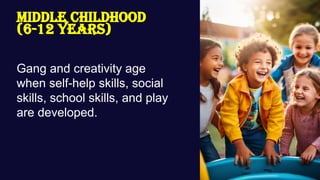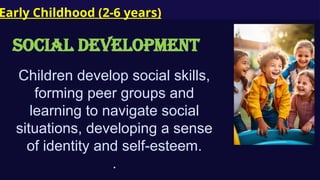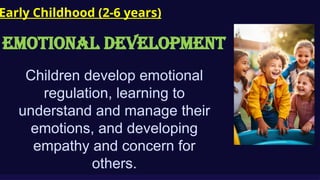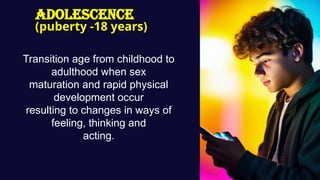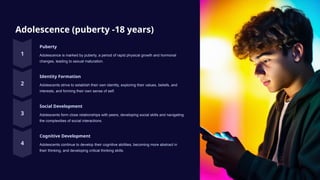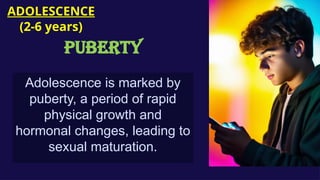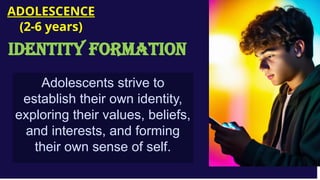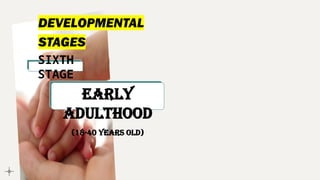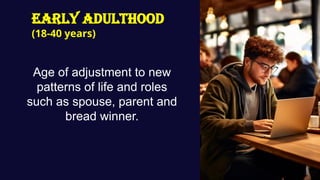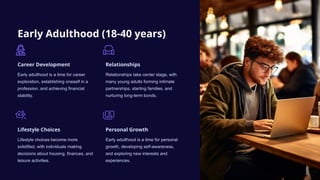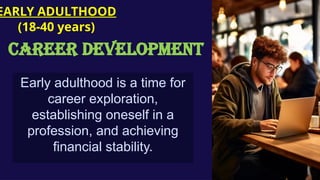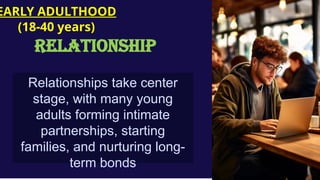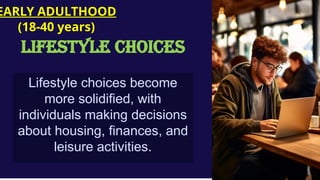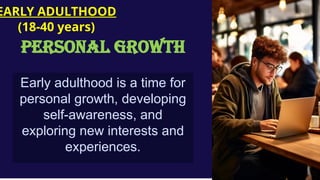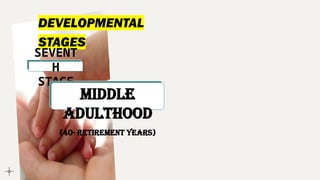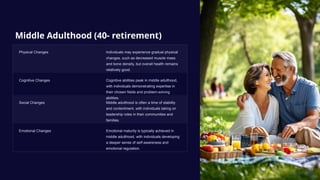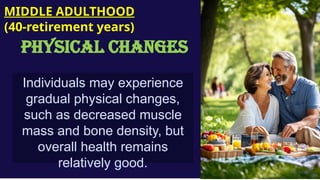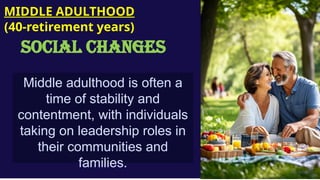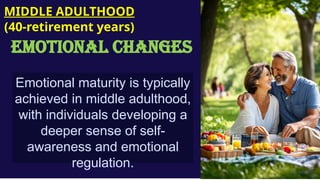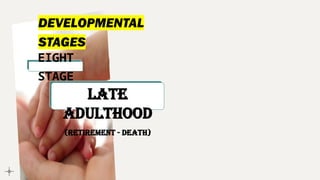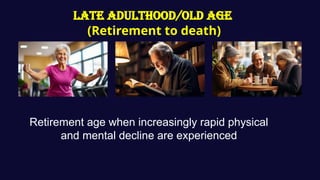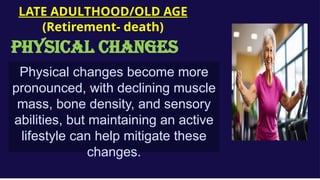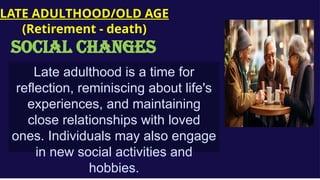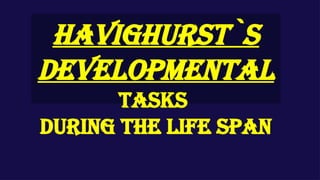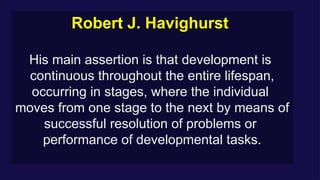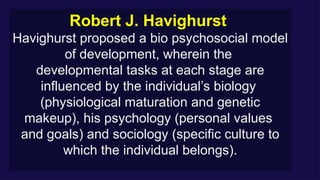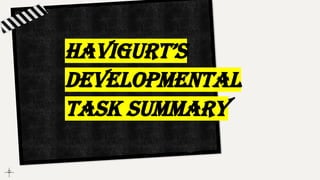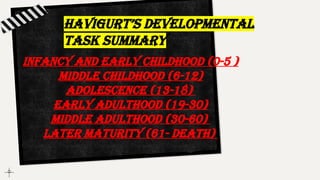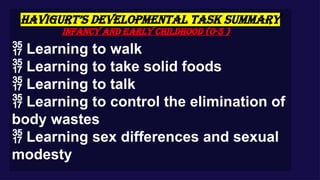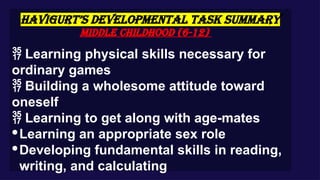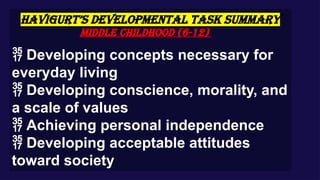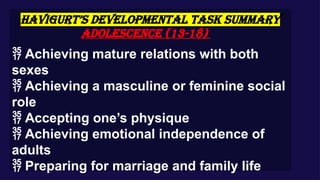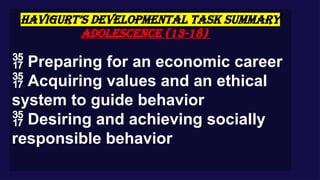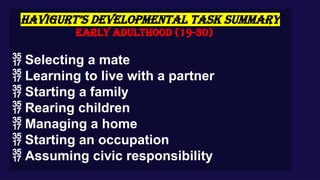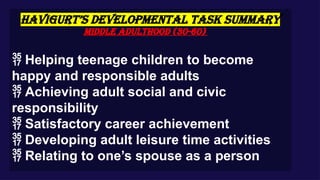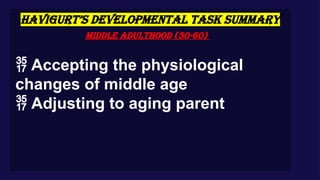PERDEV-WEEK highschool senior high pptx.
- 5. PRENATAL DEVELOPMENT (Conception-birth) Age when hereditary endowments and sex are fixed and all body features, both external and internal are developed.
- 6. PRENATAL DEVELOPMENT (Conception-birth) 1 Germinal Stage (week 1-2) From conception to two weeks, the zygote implants in the uterine wall, forming a blastocyst. 2 Embryonic Stage (week 3-8) From two to eight weeks, major organs and body systems develop, and the embryo becomes recognizable as a human. 3 Fetal Stage (week 9-birth) From eight weeks to birth, further growth and development occur, and the fetus gains weight and muscle mass.
- 8. INFANCY (0-2 years) Foundation age when basic behavior is organized and many onto-genetic maturation skills are developed.
- 9. Infancy (0-2 years) 1 RAPID PHYSICAL GROWTH Infants grow rapidly in size and weight, developing motor skills like rolling, sitting, and walking.
- 10. Infancy (0-2 years) LANGUAGE DEVELOPMENT Infants begin to babble and coo, eventually developing the ability to understand and produce words.
- 11. Infancy (0-2 years) Attachment Formation Infants form strong emotional bonds with caregivers, which provide security and support.
- 12. Infancy (0-2 years) Social Development Infants learn to interact with others, developing social skills like smiling, laughing, and playing.
- 14. Early Childhood (2-6 years) Physical DevelopmentCognitive Development Social Development Pre-gang age, exploratory, and questioning. Language and Elementary reasoning are acquired and initial socialization is experienced.
- 15. Early Childhood (2-6 years) Physical Development Children refine their motor skills, becoming more coordinated and able to perform complex tasks, like drawing and writing.
- 16. Early Childhood (2-6 years) COGNITIVE Development Children develop symbolic thought, allowing them to use language and engage in pretend play, advancing their understanding of the world.
- 17. Early Childhood (2-6 years) SOCIAL Development Children learn to share, cooperate, and interact with others, developing friendships and social skills.
- 19. Middle Childhood (6-12 years) Gang and creativity age when self-help skills, social skills, school skills, and play are developed.
- 20. Early Childhood (2-6 years) PHYSICAL Development Children continue to grow physically, their bodies become stronger and more coordinated, and they are increasingly capable of performing physical activities.
- 21. Early Childhood (2-6 years) COGNITIVE Development Children develop their cognitive skills, including problem- solving, reasoning, and memory, as they begin to engage in more abstract thinking.
- 22. Early Childhood (2-6 years) SOCIAL Development Children develop social skills, forming peer groups and learning to navigate social situations, developing a sense of identity and self-esteem. .
- 23. Early Childhood (2-6 years) EMOTIONAL Development Children develop emotional regulation, learning to understand and manage their emotions, and developing empathy and concern for others.
- 25. Adolescence (puberty -18 years) Transition age from childhood to adulthood when sex maturation and rapid physical development occur resulting to changes in ways of feeling, thinking and acting.
- 26. Adolescence (puberty -18 years) Puberty Adolescence is marked by puberty, a period of rapid physical growth and hormonal changes, leading to sexual maturation. Identity Formation Adolescents strive to establish their own identity, exploring their values, beliefs, and interests, and forming their own sense of self. Social Development Adolescents form close relationships with peers, developing social skills and navigating the complexities of social interactions. Cognitive Development Adolescents continue to develop their cognitive abilities, becoming more abstract in their thinking, and developing critical thinking skills.
- 27. Adolescence is marked by puberty, a period of rapid physical growth and hormonal changes, leading to sexual maturation. ADOLESCENCE (2-6 years) Puberty
- 28. Adolescents strive to establish their own identity, exploring their values, beliefs, and interests, and forming their own sense of self. ADOLESCENCE (2-6 years) Identity Formation
- 29. Adolescents form close relationships with peers, developing social skills and navigating the complexities of social interactions. ADOLESCENCE (2-6 years) SOCIAL DEVELOPMENT
- 30. Adolescents continue to develop their cognitive abilities, becoming more abstract in their thinking, and developing critical thinking skills. ADOLESCENCE (2-6 years) COGNITIVE DEVELOPMENT
- 32. EARLY ADULTHOOD (18-40 years) Age of adjustment to new patterns of life and roles such as spouse, parent and bread winner.
- 33. Early Adulthood (18-40 years) Career Development Early adulthood is a time for career exploration, establishing oneself in a profession, and achieving financial stability. Relationships Relationships take center stage, with many young adults forming intimate partnerships, starting families, and nurturing long-term bonds. Lifestyle Choices Lifestyle choices become more solidified, with individuals making decisions about housing, finances, and leisure activities. Personal Growth Early adulthood is a time for personal growth, developing self-awareness, and exploring new interests and experiences.
- 34. Early adulthood is a time for career exploration, establishing oneself in a profession, and achieving financial stability. EARLY ADULTHOOD (18-40 years) CAREER DEVELOPMENT
- 35. Relationships take center stage, with many young adults forming intimate partnerships, starting families, and nurturing long- term bonds EARLY ADULTHOOD (18-40 years) RELATIONSHIP
- 36. Lifestyle choices become more solidified, with individuals making decisions about housing, finances, and leisure activities. EARLY ADULTHOOD (18-40 years) LIFESTYLE CHOICES
- 37. Early adulthood is a time for personal growth, developing self-awareness, and exploring new interests and experiences. EARLY ADULTHOOD (18-40 years) PERSONAL GROWTH
- 39. Middle Adulthood (40- retirement) Transition age when adjustments to initial physical and mental decline are experienced.
- 40. Middle Adulthood (40- retirement) Physical Changes Individuals may experience gradual physical changes, such as decreased muscle mass and bone density, but overall health remains relatively good. Cognitive Changes Cognitive abilities peak in middle adulthood, with individuals demonstrating expertise in their chosen fields and problem-solving abilities. Social Changes Middle adulthood is often a time of stability and contentment, with individuals taking on leadership roles in their communities and families. Emotional Changes Emotional maturity is typically achieved in middle adulthood, with individuals developing a deeper sense of self-awareness and emotional regulation.
- 41. Individuals may experience gradual physical changes, such as decreased muscle mass and bone density, but overall health remains relatively good. MIDDLE ADULTHOOD (40-retirement years) PHYSICAL CHANGES
- 42. Cognitive abilities peak in middle adulthood, with individuals demonstrating expertise in their chosen fields and problem-solving abilities. MIDDLE ADULTHOOD (40-retirement years) COGNITIVE CHANGES
- 43. Middle adulthood is often a time of stability and contentment, with individuals taking on leadership roles in their communities and families. MIDDLE ADULTHOOD (40-retirement years) SOCIAL CHANGES
- 44. Emotional maturity is typically achieved in middle adulthood, with individuals developing a deeper sense of self- awareness and emotional regulation. MIDDLE ADULTHOOD (40-retirement years) EMOTIONAL CHANGES
- 46. Late Adulthood/OLD AGE (Retirement to death) Retirement age when increasingly rapid physical and mental decline are experienced
- 47. Physical changes become more pronounced, with declining muscle mass, bone density, and sensory abilities, but maintaining an active lifestyle can help mitigate these changes. LATE ADULTHOOD/OLD AGE (Retirement- death) PHYSICAL CHANGES
- 48. Some cognitive decline is normal in late adulthood, but overall intellectual functioning remains relatively stable, with individuals retaining their wisdom and accumulated knowledge. LATE ADULTHOOD/OLD AGE (Retirement - death) cognitive CHANGES
- 49. Late adulthood is a time for reflection, reminiscing about life's experiences, and maintaining close relationships with loved ones. Individuals may also engage in new social activities and hobbies. LATE ADULTHOOD/OLD AGE (Retirement - death) social CHANGES
- 50. LATE ADULTHOOD/OLD AGE Physical, Cognitive, Emotional, and Social Changes Each stage of development involves a complex interplay of physical, cognitive, emotional, and social changes. These changes are interconnected and influence one another, shaping the individual's overall development and well- being.
- 52. Robert J. Havighurst elaborated on the Developmental Tasks Theory in the most systematic and extensive manner
- 53. Robert J. Havighurst His main assertion is that development is continuous throughout the entire lifespan, occurring in stages, where the individual moves from one stage to the next by means of successful resolution of problems or performance of developmental tasks.
- 54. Robert J. Havighurst Havighurst proposed a bio psychosocial model of development, wherein the developmental tasks at each stage are influenced by the individualŌĆÖs biology (physiological maturation and genetic makeup), his psychology (personal values and goals) and sociology (specific culture to which the individual belongs).
- 56. HAVIGURTŌĆÖS DEVELOPMENTAL TASK SUMMARY infancy and Early Childhood (0-5 ) Middle Childhood (6-12) Adolescence (13-18) Early Adulthood (19-30) Middle Adulthood (30-60) Later Maturity (61- death)
- 57. HAVIGURTŌĆÖS DEVELOPMENTAL TASK SUMMARY Infancy and Early Childhood (0-5 ) ’éĘ Learning to walk ’éĘ Learning to take solid foods ’éĘ Learning to talk ’éĘ Learning to control the elimination of body wastes ’éĘ Learning sex differences and sexual modesty
- 58. HAVIGURTŌĆÖS DEVELOPMENTAL TASK SUMMARY Infancy and Early Childhood (0-5 ) ┬Ę Readiness for reading ┬Ę Learning to distinguish right from wrong and developing a conscience ’éĘ Acquiring concepts and language to describe social and physical reality
- 59. HAVIGURTŌĆÖS DEVELOPMENTAL TASK SUMMARY Middle Childhood (6-12) ’éĘ Learning physical skills necessary for ordinary games ’éĘ Building a wholesome attitude toward oneself ’éĘ Learning to get along with age-mates ┬ĘLearning an appropriate sex role ┬ĘDeveloping fundamental skills in reading, writing, and calculating
- 60. HAVIGURTŌĆÖS DEVELOPMENTAL TASK SUMMARY Middle Childhood (6-12) ’éĘ Developing concepts necessary for everyday living ’éĘ Developing conscience, morality, and a scale of values ’éĘ Achieving personal independence ’éĘ Developing acceptable attitudes toward society
- 61. HAVIGURTŌĆÖS DEVELOPMENTAL TASK SUMMARY Adolescence (13-18) ’éĘ Achieving mature relations with both sexes ’éĘ Achieving a masculine or feminine social role ’éĘ Accepting oneŌĆÖs physique ’éĘ Achieving emotional independence of adults ’éĘ Preparing for marriage and family life
- 62. HAVIGURTŌĆÖS DEVELOPMENTAL TASK SUMMARY Adolescence (13-18) ’éĘ Preparing for an economic career ’éĘ Acquiring values and an ethical system to guide behavior ’éĘ Desiring and achieving socially responsible behavior
- 63. HAVIGURTŌĆÖS DEVELOPMENTAL TASK SUMMARY Early Adulthood (19-30) ’éĘ Selecting a mate ’éĘ Learning to live with a partner ’éĘ Starting a family ’éĘ Rearing children ’éĘ Managing a home ’éĘ Starting an occupation ’éĘ Assuming civic responsibility
- 64. HAVIGURTŌĆÖS DEVELOPMENTAL TASK SUMMARY Middle Adulthood (30-60) ’éĘ Helping teenage children to become happy and responsible adults ’éĘ Achieving adult social and civic responsibility ’éĘ Satisfactory career achievement ’éĘ Developing adult leisure time activities ’éĘ Relating to oneŌĆÖs spouse as a person
- 65. HAVIGURTŌĆÖS DEVELOPMENTAL TASK SUMMARY Middle Adulthood (30-60) ’éĘ Accepting the physiological changes of middle age ’éĘ Adjusting to aging parent
- 66. HAVIGURTŌĆÖS DEVELOPMENTAL TASK SUMMARY Later Maturity (61- death) ’éĘ Adjusting to decreasing strength and health ’éĘ Adjusting to retirement and reduced income ’éĘ Adjusting to death of spouse ’éĘ Establishing relations with oneŌĆÖs own age group ’éĘ Meeting social and civic obligations ’éĘ Establishing satisfactory living quarters
